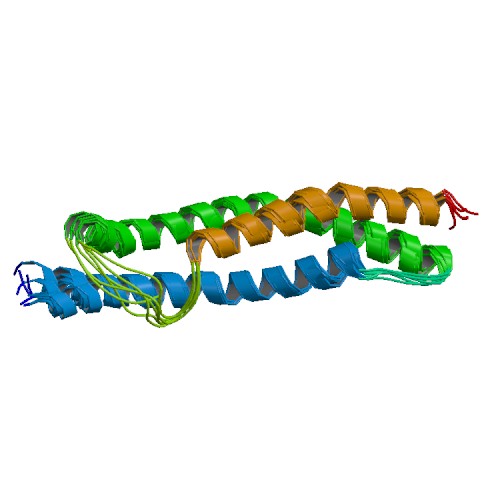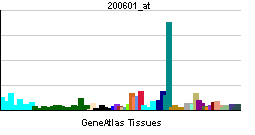Actinin alpha 4
| Actinin, alpha 4 | |||||||||||||
|---|---|---|---|---|---|---|---|---|---|---|---|---|---|
 PDB rendering based on 1wlx. | |||||||||||||
| |||||||||||||
| Identifiers | |||||||||||||
| Symbols | ACTN4 ; DKFZp686K23158; FSGS; FSGS1 | ||||||||||||
| External IDs | Template:OMIM5 Template:MGI HomoloGene: 55857 | ||||||||||||
| RNA expression pattern | |||||||||||||
 | |||||||||||||
| More reference expression data | |||||||||||||
| Orthologs | |||||||||||||
| Template:GNF Ortholog box | |||||||||||||
| Species | Human | Mouse | |||||||||||
| Entrez | n/a | n/a | |||||||||||
| Ensembl | n/a | n/a | |||||||||||
| UniProt | n/a | n/a | |||||||||||
| RefSeq (mRNA) | n/a | n/a | |||||||||||
| RefSeq (protein) | n/a | n/a | |||||||||||
| Location (UCSC) | n/a | n/a | |||||||||||
| PubMed search | n/a | n/a | |||||||||||
Actinin, alpha 4, also known as ACTN4, is a human gene.[1]
Alpha actinins belong to the spectrin gene superfamily which represents a diverse group of cytoskeletal proteins, including the alpha and beta spectrins and dystrophins. Alpha actinin is an actin-binding protein with multiple roles in different cell types. In nonmuscle cells, the cytoskeletal isoform is found along microfilament bundles and adherens-type junctions, where it is involved in binding actin to the membrane. In contrast, skeletal, cardiac, and smooth muscle isoforms are localized to the Z-disc and analogous dense bodies, where they help anchor the myofibrillar actin filaments. This gene encodes a nonmuscle, alpha actinin isoform which is concentrated in the cytoplasm, and thought to be involved in metastatic processes. Mutations in this gene have been associated with focal and segmental glomerulosclerosis.[1]
References
Further reading
- Dawson SJ, White LA (1992). "Treatment of Haemophilus aphrophilus endocarditis with ciprofloxacin". J. Infect. 24 (3): 317–20. PMID 1602151.
- Yürüker B, Niggli V (1992). "Alpha-actinin and vinculin in human neutrophils: reorganization during adhesion and relation to the actin network". J. Cell. Sci. 101 ( Pt 2): 403–14. PMID 1629252.
- Otey CA, Pavalko FM, Burridge K (1990). "An interaction between alpha-actinin and the beta 1 integrin subunit in vitro". J. Cell Biol. 111 (2): 721–9. PMID 2116421.
- Pavalko FM, LaRoche SM (1993). "Activation of human neutrophils induces an interaction between the integrin beta 2-subunit (CD18) and the actin binding protein alpha-actinin". J. Immunol. 151 (7): 3795–807. PMID 8104223.
- Mathis BJ, Kim SH, Calabrese K; et al. (1998). "A locus for inherited focal segmental glomerulosclerosis maps to chromosome 19q13". Kidney Int. 53 (2): 282–6. doi:10.1046/j.1523-1755.1998.00828.x. PMID 9461087.
- Honda K, Yamada T, Endo R; et al. (1998). "Actinin-4, a novel actin-bundling protein associated with cell motility and cancer invasion". J. Cell Biol. 140 (6): 1383–93. PMID 9508771.
- Zhang H, Wang L, Kao S; et al. (1999). "Functional interaction between the cytoplasmic leucine-zipper domain of HIV-1 gp41 and p115-RhoGEF". Curr. Biol. 9 (21): 1271–4. PMID 10556093.
- Nikolopoulos SN, Spengler BA, Kisselbach K; et al. (2000). "The human non-muscle alpha-actinin protein encoded by the ACTN4 gene suppresses tumorigenicity of human neuroblastoma cells". Oncogene. 19 (3): 380–6. doi:10.1038/sj.onc.1203310. PMID 10656685.
- El-Husseini AE, Kwasnicka D, Yamada T; et al. (2000). "BERP, a novel ring finger protein, binds to alpha-actinin-4". Biochem. Biophys. Res. Commun. 267 (3): 906–11. doi:10.1006/bbrc.1999.2045. PMID 10673389.
- Kaplan JM, Kim SH, North KN; et al. (2000). "Mutations in ACTN4, encoding alpha-actinin-4, cause familial focal segmental glomerulosclerosis". Nat. Genet. 24 (3): 251–6. doi:10.1038/73456. PMID 10700177.
- Vallenius T, Luukko K, Mäkelä TP (2000). "CLP-36 PDZ-LIM protein associates with nonmuscle alpha-actinin-1 and alpha-actinin-4". J. Biol. Chem. 275 (15): 11100–5. PMID 10753915.
- Holliday LS, Lu M, Lee BS; et al. (2000). "The amino-terminal domain of the B subunit of vacuolar H+-ATPase contains a filamentous actin binding site". J. Biol. Chem. 275 (41): 32331–7. doi:10.1074/jbc.M004795200. PMID 10915794.
- Walikonis RS, Oguni A, Khorosheva EM; et al. (2001). "Densin-180 forms a ternary complex with the (alpha)-subunit of Ca2+/calmodulin-dependent protein kinase II and (alpha)-actinin". J. Neurosci. 21 (2): 423–33. PMID 11160423.
- Echchakir H, Mami-Chouaib F, Vergnon I; et al. (2001). "A point mutation in the alpha-actinin-4 gene generates an antigenic peptide recognized by autologous cytolytic T lymphocytes on a human lung carcinoma". Cancer Res. 61 (10): 4078–83. PMID 11358829.
- Xu F, Zhao R, Peng Y; et al. (2001). "Association of tyrosine phosphatase SHP-2 with F-actin at low cell densities". J. Biol. Chem. 276 (31): 29479–84. doi:10.1074/jbc.M104428200. PMID 11382784.
- Hüttelmaier S, Illenberger S, Grosheva I; et al. (2002). "Raver1, a dual compartment protein, is a ligand for PTB/hnRNPI and microfilament attachment proteins". J. Cell Biol. 155 (5): 775–86. doi:10.1083/jcb.200105044. PMID 11724819.
- Renoult C, Blondin L, Fattoum A; et al. (2002). "Binding of gelsolin domain 2 to actin. An actin interface distinct from that of gelsolin domain 1 and from ADF/cofilin". Eur. J. Biochem. 268 (23): 6165–75. PMID 11733011.
- Gonzalez AM, Otey C, Edlund M, Jones JC (2002). "Interactions of a hemidesmosome component and actinin family members". J. Cell. Sci. 114 (Pt 23): 4197–206. PMID 11739652.
- Lukoyanova N, VanLoock MS, Orlova A; et al. (2002). "Each actin subunit has three nebulin binding sites: implications for steric blocking". Curr. Biol. 12 (5): 383–8. PMID 11882289.
- Kim JH, Lee-Kwon W, Park JB; et al. (2002). "Ca(2+)-dependent inhibition of Na+/H+ exchanger 3 (NHE3) requires an NHE3-E3KARP-alpha-actinin-4 complex for oligomerization and endocytosis". J. Biol. Chem. 277 (26): 23714–24. doi:10.1074/jbc.M200835200. PMID 11948184.
| This protein-related article is a stub. You can help Wikipedia by expanding it. |